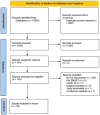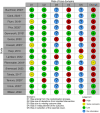The use of sequential multiple assignment randomized trials (SMARTs) in physical activity interventions: a systematic review
- PMID: 39701990
- PMCID: PMC11658464
- DOI: 10.1186/s12874-024-02439-4
The use of sequential multiple assignment randomized trials (SMARTs) in physical activity interventions: a systematic review
Abstract
Background: Physical activity (PA) is often the cornerstone in risk-reduction interventions for the prevention and treatment of many chronic health conditions. PA interventions are inherently multi-dimensional and complex in nature. Thus, study designs used in the evaluation of PA interventions must be adaptive to intervention components and individual capacities. A Sequential Multiple Assignment Randomised Trial (SMART) is a factorial design in a sequential setting used to build effective adaptive interventions. SMARTs represent a relatively new design for PA intervention research. This systematic review aims to examine the state-of-the-art of SMARTs used to develop PA interventions, with a focus on study characteristics, design, and analyses.
Methods: PubMed, Embase, PsychINFO, CENTRAL, and CinAHL were systematically searched through May 2023 for studies wherein PA SMARTs were conducted. Methodological quality was assessed using the Cochrane Risk of Bias 2 Tool.
Results: Twenty studies across a variety of populations - e.g., obesity, chronic pain, and cardiovascular conditions, were included. All PA SMARTs involved two decision stages, with the majority including two initial treatment options. PA interventions most commonly consisted of individual aerobic exercise with strategies such as goal setting, wearable technology, and motivational interviewing also used to promote PA. Variation was observed across tailoring variables and timing of tailoring variables. Non-response strategies primarily involved augmenting and switching treatment options, and for responders to continue with initial treatment options. For analyses, most sample size estimations and outcome analyses accounted for the SMART aims specified. Techniques such as linear mixed models, weighted regressions, and Q-learning regression were frequently used. Risk of bias was high across the majority of included studies.
Conclusions: Individual-based aerobic exercise interventions supported by behaviour change techniques and wearable sensing technology may play a key role in the future development of SMARTs addressing PA intervention development. Clearer rationale for the selection of tailoring variables, timing of tailoring variables, and included measures is essential to advance PA SMART designs. Collaborative efforts from researchers, clinicians, and patients are needed in order to bridge the gap between adaptive research designs and personalised treatment pathways observed in clinical practice.
Keywords: Physical activity; Sequential multiple assignment randomised trial; Systematic review.
© 2024. The Author(s).
Conflict of interest statement
Declarations. Ethics approval and consent to participate: Not applicable. Consent for publication: Not applicable. Competing interests: The authors declare no competing interests.
Figures
Similar articles
-
The future of Cochrane Neonatal.Early Hum Dev. 2020 Nov;150:105191. doi: 10.1016/j.earlhumdev.2020.105191. Epub 2020 Sep 12. Early Hum Dev. 2020. PMID: 33036834
-
Behavioural modification interventions for medically unexplained symptoms in primary care: systematic reviews and economic evaluation.Health Technol Assess. 2020 Sep;24(46):1-490. doi: 10.3310/hta24460. Health Technol Assess. 2020. PMID: 32975190 Free PMC article.
-
Strategies to improve the implementation of workplace-based policies or practices targeting tobacco, alcohol, diet, physical activity and obesity.Cochrane Database Syst Rev. 2018 Nov 14;11(11):CD012439. doi: 10.1002/14651858.CD012439.pub2. Cochrane Database Syst Rev. 2018. PMID: 30480770 Free PMC article.
-
Use of research electronic data capture (REDCap) in a sequential multiple assignment randomized trial (SMART): a practical example of automating double randomization.BMC Med Res Methodol. 2023 Jul 6;23(1):162. doi: 10.1186/s12874-023-01986-6. BMC Med Res Methodol. 2023. PMID: 37415099 Free PMC article. Clinical Trial.
-
Use of research electronic data capture (REDCap) in a sequential multiple assignment randomized trial (SMART): A practical example of automating double randomization.Res Sq [Preprint]. 2023 Feb 24:rs.3.rs-2573133. doi: 10.21203/rs.3.rs-2573133/v1. Res Sq. 2023. Update in: BMC Med Res Methodol. 2023 Jul 6;23(1):162. doi: 10.1186/s12874-023-01986-6. PMID: 36865151 Free PMC article. Updated. Preprint.
References
-
- Organization WH. Global action plan on physical activity 2018–2030: more active people for a healthier world. World Health Organization; 2019.
-
- Rietz M, Lehr A, Mino E, Lang A, Szczerba E, Schiemann T, Herder C, Saatmann N, Geidl W, Barbaresko J, et al. Physical activity and risk of major diabetes-related complications in individuals with diabetes: a systematic review and Meta-analysis of Observational studies. Diabetes Care. 2022;45(12):3101–11. - PMC - PubMed
Publication types
MeSH terms
Grants and funding
LinkOut - more resources
Full Text Sources
Medical
Miscellaneous



